Family Bike Riding
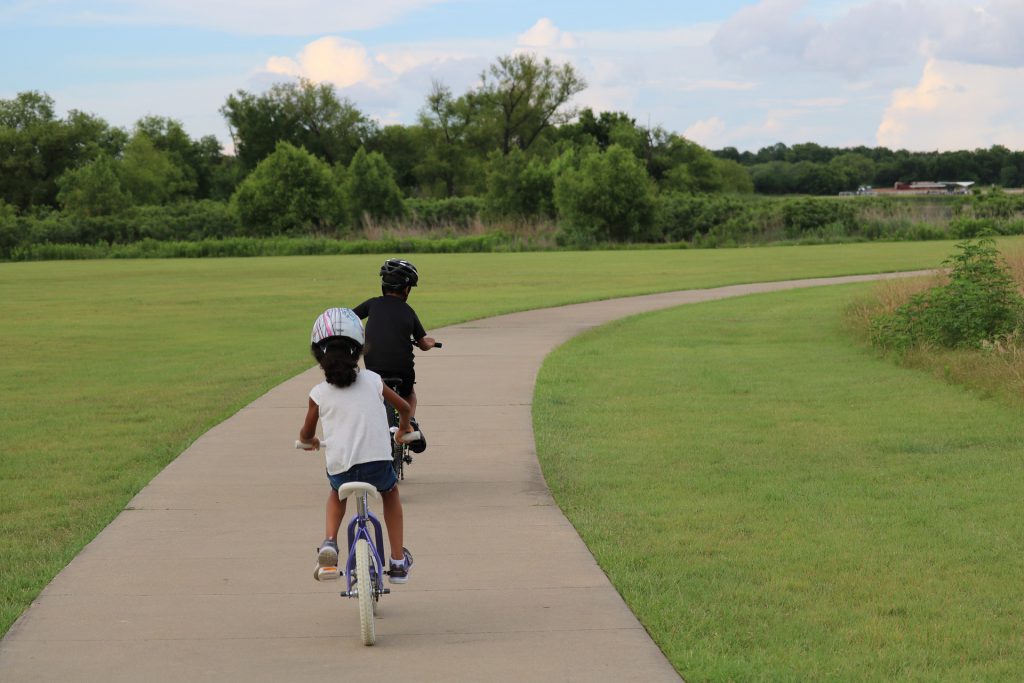
Riding bikes is fun exercise, especially as a family. No matter what age, children can enjoy riding a bike. Toddlers and preschoolers can ride tricycles, and children who haven’t learned how to ride a two-wheel bike can ride a bike with training wheels. You can also ride bikes in all kinds of settings–the driveway, bike lanes, and bike trails. For toddlers and preschoolers, the driveway or a sidewalk are safer options until they learn how to safely ride a bike with training wheels or a two-wheeler.
No matter what bike your child rides, safety is the first priority. Children (and adults!) should wear a properly-fitting helmet. Also, the bike should also be the right size so they can reach the pedals and the brakes. The bike should also be adjusted to fit your child’s height. They should be able to touch the ground with both feet when the seat is at its lowest position, and their legs should be slightly bent when their pedal is closest to the ground. Make bike rides a fun family outing! Older children who are more experienced with biking can join you for a long bike ride. Make sure you take water, sunscreen, and snacks!
For more bike riding tips and to learn how to teach your child how to ride a bike, visit http://www.parents.com/fun/sports/exercise/bicycle-riding/.
When will you get your children started with bike riding?
Jump Rope
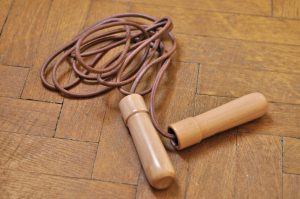
Jumping rope is a great way to exercise and make your heart work hard. People in countries all over the world jump rope as a way to stay fit and healthy. There’s even an event at the Olympics for jump rope! It’s also a great activity for both children and adults, making it a fun way to exercise as a family.
To make sure you and your children are safe while jump roping, it’s important to size your rope. Stand in the middle of it and make sure the handles come below your underarms. Test out the size before purchasing a new jump rope. If you haven’t jump roped before, it’s okay! Make sure to take it slow until you’re more comfortable going faster. Many school physical education classes teach jump rope, so if your children are already familiar with it they can show you the ropes!
For step by step instructions visit: http://go.ncsu.edu/heartjumpropeskills
What jump rope skills will you can your children practice this week?
Simon Says
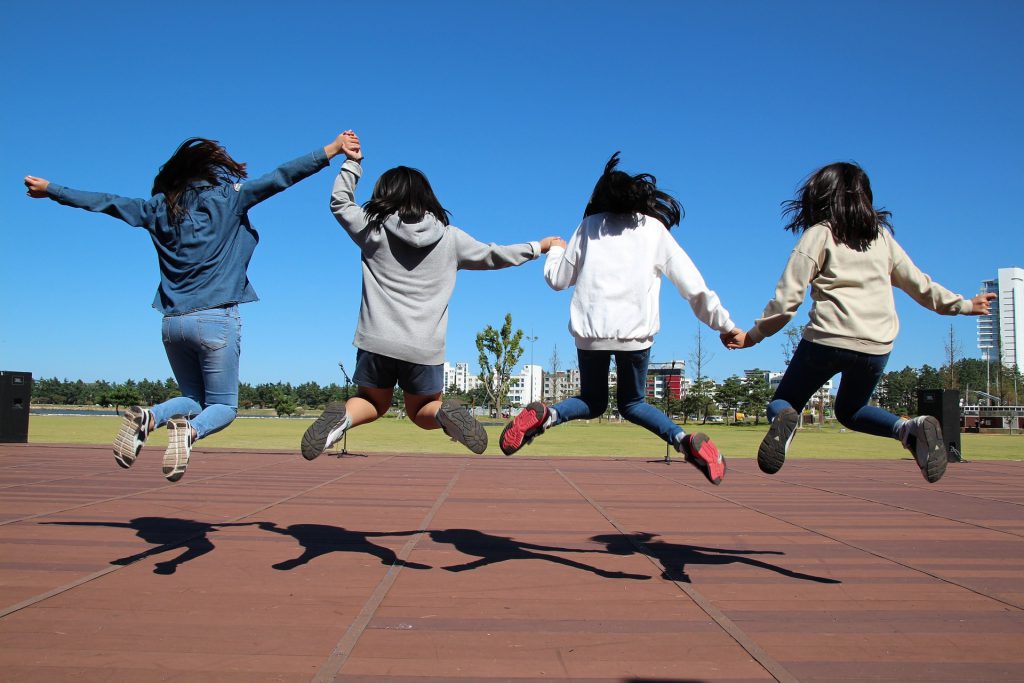
Simon Says is a great game for kids of all ages because you can include easier or more difficult movements as appropriate. Also, there’s no minimum or maximum number of participants, so no matter how big your family is, everyone can play! You can even play inside or outside–whichever your children prefer.
Choose one person to be “Simon” first. “Simon” will call out exercises for the group to do. The group should only do the exercise if “Simon says” to do it. If someone does the exercise and “Simon” did not say “Simon says,” that person must sit down. Here are some ideas of different exercises the group can do:
- Run in place
- Hop on one foot
- Jump up and down
- Play basketball
- Swim
- Dance
- Shake all over
- March in place
- Clap your hands behind your back
- Jumping jacks
What exercises will you have your children do when you’re “Simon?”
Roller Skating
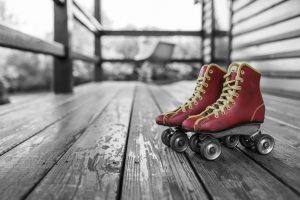
Roller skating and roller blading (also called inline skating) are fun activities for children to learn when they’re old enough. Roller skates have 4 wheels arranged in two side-by-side pairs, while roller blades/inline skates have 4 wheels in a row. Roller skates are usually used on an indoor rink and roller blades outside, though you can use both in either setting. Roller blades allow you to go faster than roller skates, but they are also less stable than roller skates, so children new to skating may prefer to start with roller skates.
Some children can start skating as young as preschool if they show interest, but remember that every child’s readiness for physical activity is different. There are roller skates designed for preschoolers with adjustable wheels you can try. Once new skaters become comfortable with standing on skates, they can try moving forward on the skates and proper stopping technique. Advanced skaters can learn more difficult techniques and may be interested in switching from roller skating to roller blading. Young skaters should always have adult supervision. Older children may not need adult supervision while skating, depending on their skill level, but they should at least skate with a friend.
Roller skating is great aerobic exercise, as it can get your heart rate up to 140-160 beats per minute, and even up to 180 beats per minute if you skate vigorously. Not only is roller skating good for your heart, but it also helps build strong muscles. It uses most muscle groups, including your glutes, quads, abs, calves, and arms. Roller skating at a moderate speed for an hour can even burn 330 calories!
Roller skaters can get hurt if they lose balance and fall down, especially when they are first learning how to skate. Wearing proper safety gear can help prevent injuries while skating. As with biking, helmets are a top priority. A bike helmet will work fine, but if your child skates often, they should wear an inline skating or skateboarding helmet which provides better protection for backward falls. The plastic on the skates should be strong enough that you can’t squeeze it. Also, make sure the brakes and wheels are not worn out and that skates are securely on the foot. Pads, long pants and shirts, gloves, and mouth guards can be especially helpful for outdoor skating to prevent scrapes if your child falls on concrete.
Children can skate on an indoor rink or outdoors, depending on what’s available and the child’s skill level and preference. When skating outside, try having children skate in areas without people or obstacles (e.g. empty parking lots, unused tennis courts, pavement with grass around it). Make sure children know to always be aware of other people and obstacles to avoid accidents and practice good etiquette while sharing an outdoor space. Children may also be interested in ice skating and sports that incorporate skating, such as hockey and roller derby.
To learn more about roller skating fundamentals, visit http://www.rollerskating.com/files_uploaded/93ea7feebe34c9bf8fad2142e90e83e6.pdf.
Have your children tried roller skating?
References
- http://dscdeptford.com/skates-or-blades/
- http://www.rollerskating.com/pages/all+about+roller+skating/51
- http://kidshealth.org/en/teens/safety-inline.html#
Hula Hoop
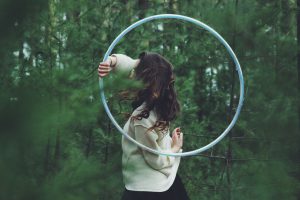
Hula hooping is an inexpensive way to fit in physical activity. If you practice, you’ll not only improve your skills, but you’ll get a great workout! There are many different sizes of hula hoops, so you can choose hoops appropriate for children of all ages and even get one for yourself. After all, activities like hula hooping are more fun with the whole family!
Before you begin, make sure the hula hoop is the right size. If you place it in front of you, it should stand between your belly button and chest. Also, larger hoops rotate more slowly than smaller hoops, so starting with a larger hoop may be easier for beginners. Once you have a proper size hula hoop, step inside, hold it around your waist, give it a push, and shift your weight with the hoop as it moves. Hula hooping isn’t just for your waist–you can even hula hoop around your arm, knee, and leg doing all kinds of tricks. The possibilities are endless! Always make sure to give yourself plenty of room so you don’t accidentally hit anyone. Don’t have a hula hoop? You can make your own! This is also a great method to ensure you have the right size hula hoop.
Did you know World Hula Hoop Day exists? The first Saturday in October, every year people from all over the world gather to hula hoop the day away and promote peace. To learn more about hula hooping and how to do it, visit http://www.hooping.org/2003/08/how-to-hula-hoop/.
Share what hula hoop techniques your children learn!